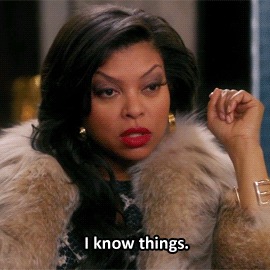Becoming is tight. Like its author, Michelle Obama's memoir is expressive, controlled, and relentlessly on-message. It's so inspiring that halfway through, I decided my kid is going to be the next President of the US. Which one, you ask? Both, of course! They can take turns.
Everything about this book is organized around Obama's core themes. The title immediately informs readers that Obama was shaped by, and continues to be shaped by, those around her as well her own strong personality. The chapter titles--Becoming Me, Becoming Us, and Becoming More--are perfect descriptors of the periods covered. And finally, the memories and events that Obama chooses to include all underline the lessons that she hopes to share with her readers: approach life with hard work and discipline, give back to society, and be grateful for your blessings rather than dwell on what seems to be lacking.
The first chapter, Becoming Me, shows the close-knit, close-quartered family unit of the Robinsons. There are barbecues and music! There are also reflections about black neighborhoods' slide into poverty in Chicago, seeing her parents work tirelessly to provide for her and her brother, and her determination to be successful. One particular vignette stands out: a school counselor telling her that she wasn't "Princeton material," and guess where Michelle Obama went to college? Why, somewhere in NJ! In short, this chapter is about a girl who was going places.
The second chapter, Becoming Us, is about her romance with Barack, who comes across as nerdy and often in his own head, trying to fix the wrongs of the world. The most memorable bit in this chapter is when she asks him what he's thinking about and he replies, "Income inequality." That's a special guy, right there. Obama also reveals that both their girls were conceived through IVF, which I did not know, but those babies are now stunning young women, so hurray reproductive technology! Alas, politics intrude often into their young family, culminating in Barack's triumph in 2008.
Finally, Becoming More is about the family's move to the White House, and the assorted battles and initiatives she engages in as First Lady. She glosses over the ugly parts, but makes it pretty clear that they were ugly, especially when she unequivocally ends her book with, "I am not going into politics." She can make a difference in other fields, using tools that likely won't destroy her soul.
While deeply personal, Becoming occasionally reads like a speech. For example, a section about meeting Nelson Mandela includes the word "crosscurrents," and there is no reason to use it unless water is involved, okurrr? The book can also get very pious. These two small bellyaches do not diminish the power of the work.
In conclusion, Becoming was the bestselling book of 2018 because it's powerful, well-written, and reminds us that when we lead lives of integrity and compassion, we can become more, we can transcend the small and the petty, and we can lift up others, just as we were lifted up. CAN I GET AN AMEN
TL;DR: OBAMA 2024
---
This post brought to you by unending snow!
Everything about this book is organized around Obama's core themes. The title immediately informs readers that Obama was shaped by, and continues to be shaped by, those around her as well her own strong personality. The chapter titles--Becoming Me, Becoming Us, and Becoming More--are perfect descriptors of the periods covered. And finally, the memories and events that Obama chooses to include all underline the lessons that she hopes to share with her readers: approach life with hard work and discipline, give back to society, and be grateful for your blessings rather than dwell on what seems to be lacking.
The first chapter, Becoming Me, shows the close-knit, close-quartered family unit of the Robinsons. There are barbecues and music! There are also reflections about black neighborhoods' slide into poverty in Chicago, seeing her parents work tirelessly to provide for her and her brother, and her determination to be successful. One particular vignette stands out: a school counselor telling her that she wasn't "Princeton material," and guess where Michelle Obama went to college? Why, somewhere in NJ! In short, this chapter is about a girl who was going places.
The second chapter, Becoming Us, is about her romance with Barack, who comes across as nerdy and often in his own head, trying to fix the wrongs of the world. The most memorable bit in this chapter is when she asks him what he's thinking about and he replies, "Income inequality." That's a special guy, right there. Obama also reveals that both their girls were conceived through IVF, which I did not know, but those babies are now stunning young women, so hurray reproductive technology! Alas, politics intrude often into their young family, culminating in Barack's triumph in 2008.
Finally, Becoming More is about the family's move to the White House, and the assorted battles and initiatives she engages in as First Lady. She glosses over the ugly parts, but makes it pretty clear that they were ugly, especially when she unequivocally ends her book with, "I am not going into politics." She can make a difference in other fields, using tools that likely won't destroy her soul.
While deeply personal, Becoming occasionally reads like a speech. For example, a section about meeting Nelson Mandela includes the word "crosscurrents," and there is no reason to use it unless water is involved, okurrr? The book can also get very pious. These two small bellyaches do not diminish the power of the work.
In conclusion, Becoming was the bestselling book of 2018 because it's powerful, well-written, and reminds us that when we lead lives of integrity and compassion, we can become more, we can transcend the small and the petty, and we can lift up others, just as we were lifted up. CAN I GET AN AMEN
TL;DR: OBAMA 2024
---
This post brought to you by unending snow!





















